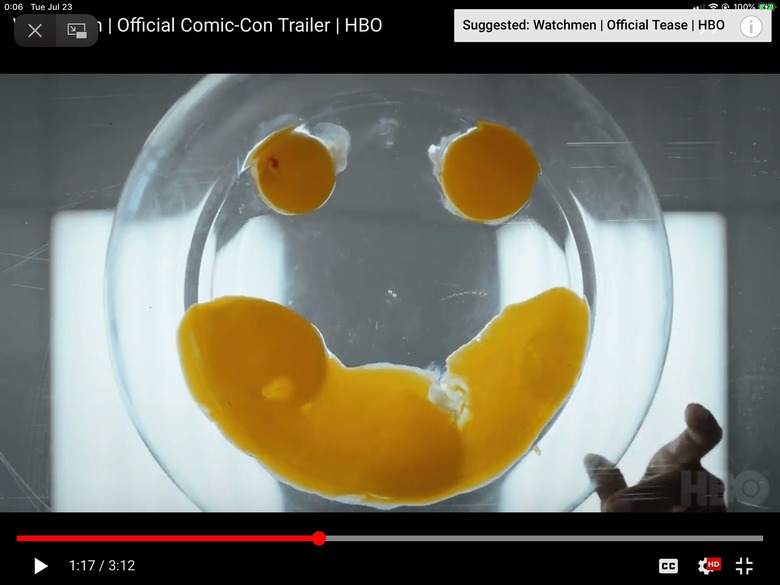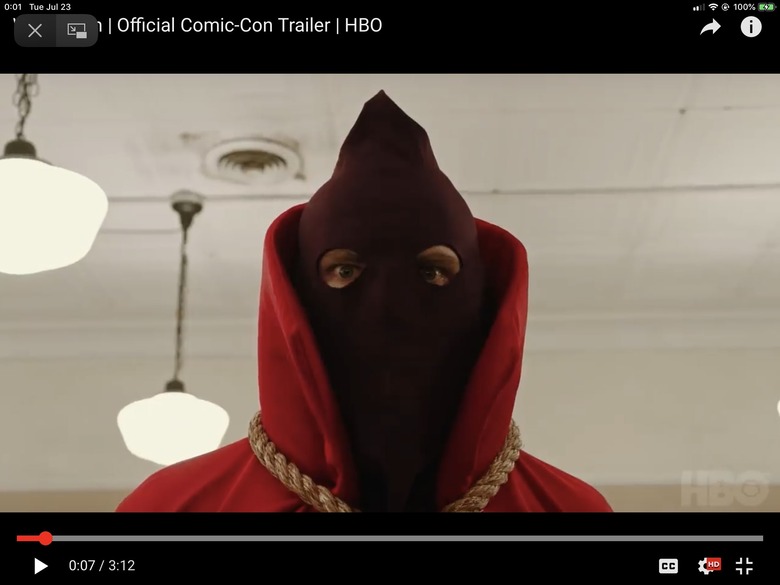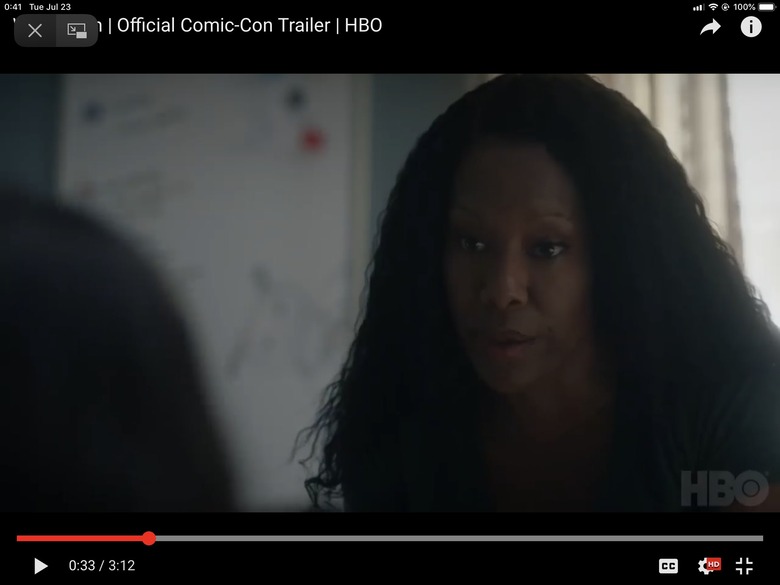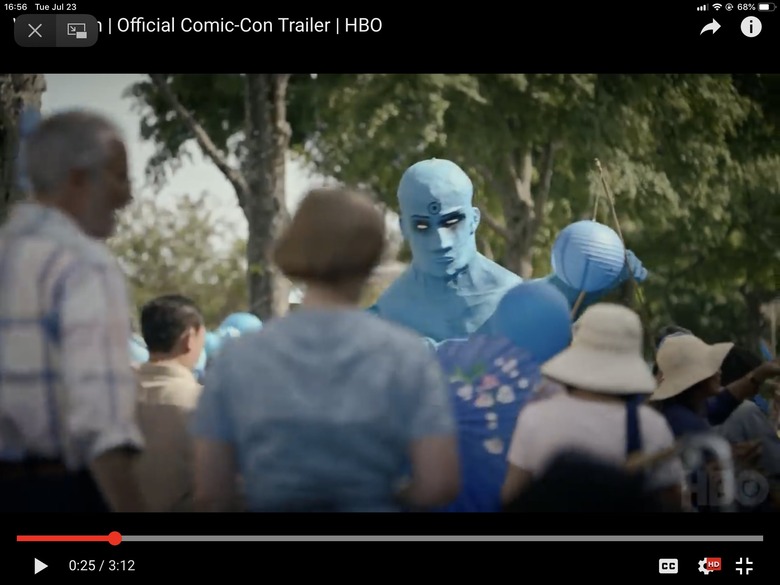HBO's 'Watchmen' Demonstrates The Right Way To "Remix" A Classic
Last year, when showrunner Damon Lindelof posted a letter to Instagram about his upcoming Watchmen series for HBO, he classified it as a "remix." On the one hand, this was good news for fans who were trepidatious about seeing the greatest comic book story of all time receive another direct sequel or adaptation. On the other hand, remixes already dominate the dance floor in Hollywood. When creators and critics use that word now, it either feels like industry code for a thinly disguised remake (amid all the other official remakes that are currently flooding the market), or it feels like a pejorative term for the repackaged greatest hits of a beloved IP.
By way of an example, this very week, we've got a new Terminator movie hitting theaters, which reviewers have likened to The Force Awakens of the franchise. However, if the first two episodes are any indication, that's not what Lindelof's Watchmen remix is. Instead, what it looks to be is a fascinating re-contextualization: a show that sets us down on familiar ground but updates it and makes it feel different enough that its echoes of Watchmen and other past superhero tales lay submerged within a fresh story.
Running Out of Ice, But Doing Fine on Eggs
The first episode of Watchmen introduced viewers to a lost episode from American history: namely, the real-life Tulsa Race Riot of 1921, otherwise known as the Black Wall Street Massacre. Two black parents emerge with their son from a movie theater into a disorienting scene where planes are flying in low overhead, smoke is rising up from storefronts, and people are being shot in the street. They're able to secure passage for their son out of town in the back of a jalopy but they themselves perish in an exploding building.
The boy, who will one day grow up to be an old man in a wheelchair, wakes up in a field just outside of Tulsa as it burns. His car has crashed, its owners are dead, and he is left alone to carry a baby wrapped in a quilt with red and white stripes.
This is America. It's also Krypton. And Gotham City. Yet the viewer is so caught up in the bedlam of the Black Wall Street Massacre that he or she might not even be cognizant that they're seeing two modern-day comics myths remixed with real American history.
That's the mark of a good narrative: it's so absorbing that you don't pay much attention to how you're being fed something old in the guise of something new. Most stories are inspired by something — usually another story, real or fictional — and they invariably follow one of a limited number of plot templates that have already been done before. Watchmen realizes this but it isn't content to be a surface-level rehash of classic comics moments. It's filled to the brim with too many other ideas, like shotguns hidden in headboards.
Sure, there are plenty of Easter eggs ... sometimes they even take the form of actual egg yolks, arranged like a smiley face with a blood drop in one eye. The crucial difference here is that the show has found a way to place these symbols in an entirely different context. Instead of Cold War nuclear tensions, Watchmen's Doomsday Clock thrives on 21st-century racial tensions. With its "Black Oklahoma" performance and role-reversed traffic stops (which still end in black men being shot), the show even remixes real-world situations, rendering them strange but familiar.
The first episode's title, "It's Summer and We're Running Out of Ice," is a line from the Rogers and Hammerstein musical Oklahoma!, but in its own way, it also recalls the heat-wave metaphor in Spike Lee's Do the Right Thing. That movie celebrated its thirtieth anniversary this summer—the day after the Comic-Con trailer for Watchmen dropped. As much as the world has changed in the last three decades, it feels like the movie's radio warnings of a heat wave with "no end in sight" have proven oracular, not only in terms of race relations, but in the overall tenor of U.S. political rhetoric.
As The Hollywood Reporter noted in January 2017 (a week after the Inauguration of Donald Trump as the 45th U.S. President), the real-life Doomsday Clock has reached a point now where it is actually closer to midnight than in the Watchmen comic. For the last two years, it's held at two minutes to midnight.
The Boy Who Would Be Hooded Justice?
Before it starts showing us remixed elements from the original Watchmen comic, the show takes us back to the superhero genre's roots. Watchmen's opening silent film, starring Bass Reeves, "The Black Marshal of Oklahoma," takes the place of the traditional Zorro movie, which has been a part of Batman's origin ever since Frank Miller's The Dark Knight Returns #1 hit newsstands in 1986. That same year, writer Alan Moore and artist Dave Gibbons invited readers into the world of Watchmen ... and comics have never been the same.
In our breakdown of it over the summer, I noted how the opening seconds of Watchmen's Comic-Con trailer gave immediate, subtle nods to Superman and Batman. That's something the show does in its opening minutes, as well. The movie theater is pure Bruce Wayne, while that burning city and the exploding building with the parents in it is pure Kal-El or Superman. Instead of a crashed rocket in a Kansas field, it's a crashed car in an Oklahoma field where the boy emerges into his new life as an orphan.
Idris Elba may claim he's "Black Superman" ... but in the context of Watchmen, Louis Gossett, Jr. seems a likelier candidate. More specifically, it's the character Gossett plays, Will, that the show seems to be positioning as its Superman. Though Will has only given us his first name on the show thus far, the IMDb credits list Gossett as playing "Will Reeves." It's conceivable that the orphaned Will might have been inspired to adopt Reeves as his surname as he struck out on his own (to fight for truth, justice, and the American way?)
We already know from the Watchmen comic that, in his fictional universe, Hooded Justice was the first-ever costumed hero. He started making public appearances in 1938, which is the same year Superman debuted in Action Comics #1. Furthermore, the name Reeves, and Will's latter-day use of a wheelchair, serves as a reminder of Christopher Reeve, the actor who played the Man of Steel in the prototypical superhero film, Superman: The Movie, only to later be paralyzed in a horse-riding accident. (The role of Superman was also played by actor George Reeves in the 1950s, another person with a similar name.)
If that weren't enough, there's also the fact that American Hero Story — Watchmen's cheeky, in-universe version of American Horror Story — went and dispelled, right out of the gate, the previously assumed identity of Hooded Justice. If he's not circus strongman Rolf Muller, as Hollis Mason speculated in his superhero autobiography Under the Hood, then who is he?
American Hero Story seems like it will function as this show's Tales of the Black Freighter, the comic-within-a-comic that served as a pirate parallel to Watchmen's main superhero narrative (especially Adrien Veidt's strand of that narrative). Lindelof has talked about "maneuver[ing] in between the cracks and crevices" of the original Watchmen comic and finding new stories there. In his Instagram letter, he said, "We also intend to revisit the past century of costumed adventuring through a surprising yet familiar set of eyes."
There's enough leeway there with Hooded Justice's identity that the show could easily make him that set of eyes. If Will is 105 years old, that would make him 7 at the time of the massacre in 1921, and 24 at the time of Hooded Justice's debut in 1938. That's just the right age for a young superhero in his physical prime, able to leap through windows in a single bound and smash heads bloody on store counters. The Hooded Justice costume, with its rope necklace and pointy hood, even seems like a natural fit for a black orphan who wanted to turn symbols of oppression into superhero emblems.
Opening up a chapter of secret history in the Watchmen world to show the first superhero as African-American would also align with the show's racial concerns. If rock 'n' roll became white through cultural appropriation, it's not a stretch to think the same process might affect superheroes in this alternate reality. There's still time for Watchmen to wiggle out from under the theory that Will Reeves is Hooded Justice, but I'm willing to bet that the show might follow through on these early clues to show us an ingenious Superman remix with something to say about the hidden heroes and villains of history. Exposing "a vast and insidious conspiracy" at the heart of the police institution, which Angela, a black woman, has heretofore trusted, would certainly give new meaning to the old question, "Who watches the Watchmen?"
Angela Abar and the New Watchmen
Part of what makes Watchmen so refreshing is the way it parcels out new bits of world-building in a judicious way, while letting the existing mythology of the graphic novel linger in the background. The show trusts the viewer to absorb references to "Redfordations" while a poster of U.S. Presidents with Robert Redford on it hangs out-of-focus on the wall behind a schoolteacher. Even when it treads turf we've already seen, it usually has a soft touch about it, so that it's not outwardly derivative or reliant on the viewer's comic expertise.
You don't have to be a hardcore fan with foreknowledge of every nook and cranny of the Watchmen mythology to appreciate what the show is doing. Even for viewers who might fit that description, there's a primacy to the plot that overrides all else. When they see Judd Crawford hanging from tree, most audience members aren't immediately going to think, "Oh, wow. That's a callback to the Comedian's death." They're going to think, "Oh, man! They killed off Don Johnson in the first episode! I thought he was one of the main heroes. His character seemed like such a nice guy."
Yet the coke-snorting Judd Crawford is, in fact, shaping up to be this show's Comedian: a morally compromised father figure whose death sets in motion the narrative's central mystery. Instead of falling out a window in the first issue, he's lynched in the first episode, with the blood drop falling on his police badge instead of the Comedian's yellow smiley face button. In the second episode, when Angela Abar (Regina King) finds the figurative skeletons in his literal closet — in the form of a white KKK robe and hood — the scene echoes Rorschach's discovery of Edward Blake's hidden Comedian costume in the comic.
For her part, Angela, AKA Sister Night, appears to fill the Nite Owl II/Batman role in this Watchmen. She's got her own Nightmobile, an all-black Buick Grand National, and her Batcave is a bakery. The reveal of her secret ancestry, meanwhile, transplants Laurie Juspeczyk's comics experience onto her—with her surprise grandfather, Will, being switched out for Laurie's surprise father, Edward Blake. Yet the twist the show puts on it is that its Comedian, the aforementioned Judd, was a false father of sorts (presuming he was palling around with Angela while being a KKK member).
Played by Jean Smart, an older version of Laurie, AKA Silk Spectre, is due to arrive in next week's episode. Given her wry manner and the fact that she's adopted her father's last name, she seems to have embraced her cynical heritage as a Blake. This makes her primed to be a good confidant or character foil for Angela, who will now have to wrestle with her own family heritage as a descendent of Will.
There's also Angela's tenuous relationship with Looking Glass (Tim Blake Nelson), which harkens back to Nite Owl II's partnership with Rorschach in the comic. Looking Glass's shiny silver mask, which reflects people's own faces back on them, is one particularly imaginative remix feat. He's shown with it rolled up over his nose, even at home when he's eating, much like Rorschach was in the comics.
The dirty ski masks of the Seventh Kavalry have proliferated the old Rorschach ink blot pattern. In the Comic-Con trailer breakdown, I noted how the Kavalry "could well serve as a parallel to toxic fandom, with its tendency to latch onto pop culture symbols and distort them to its own ends." It also clearly serves as a parallel to the alt-right, which can sometimes inform toxic fandom, leaving it with misogynist and white supremacist notions of the kind that might lead an anonymous individual to rail against "whores and race traitors." That's what we see a Seventh Kavalry member doing in a video on the show, yet it doesn't feel all that different from something you might read when wading into an especially nasty comments thread on YouTube.
As for Jeremy Irons, well, the jury's still out on that one. In its second episode, Watchmen used reverse psychology to raise the possibility that Dr. Manhattan could pose as a normal human. People seem to automatically assume that his servants are clones, but is there a chance Irons is actually Dr. Manhattan, and his servants are actually life forms he's created, per the character's final comics musings? That might explain why he's having them act out his origin on stage and why they confuse horseshoes for cake-cutting utensils.
The camera pans up to the stars before he first comes riding in on a horse, and many have noted how Dr. Manhattan's Mars sand castle on the news resembles Veidt's hermetic estate. Some Redditors have theorized that Irons is Veidt but he's imprisoned in a simulated reality, or he's trying to replicate the accident that created Dr. Manhattan, so as to attain his own godlike powers (or impart them on his butler). Whatever the case, HBO's Watchmen frames its fearful symmetry with the comic in new and interesting ways. The Adrien Veidt/Dr. Manhattan connection is just one part of a larger web.
Instead of a tight, six-person super-team, the show's new diffuse band of Watchmen represent duly authorized arms of the law: not only the police, but also the F.B.I., which we'll see next episode when Laurie makes her entrance. If Irons is playing Dr. Manhattan, wouldn't it be interesting to see him and his old lover reunite at some point later in the season?
"Nostalgia" vs. "Millennium" for the Fate of the World
With its Doomsday Clock miniseries, DC Comics is already in the midst of publishing a Watchmen sequel, and we're only ten years removed from director Zack Snyder's shaky film adaptation. This is in addition to Before Watchmen, the 2012 series of prequels that DC published—in part, no doubt, to capitalize on the mass exposure that Snyder's film had brought to the Watchmen stable of characters (who were themselves remixes of old Charlton Comics characters that DC had acquired).
Snyder's Watchmen film has its defenders, but when I rewatched the movie after the show's HBO premiere, it hit me on the level of a sophisticated sock puppet reenactment. At times, I could see where the puppeteer displayed some real technical wizardry. However, while Snyder may have nailed the visuals, I almost wanted to put his movie on mute so that I didn't have to hear Billy Crudup's emo Dr. Manhattan voice, or the on-the-nose soundtrack cues (Philip Glass notwithstanding), or the unnecessary bits of added dialogue like, "You have an idealized mankind but you've deformed it, you've mutilated it!"
Moments like that give the movie the air of a falsely profound, emotionally untruthful, if not altogether vapid translation of a comic book masterpiece. More than anything, rewatching it just made me want to go straight back to the source and reread the original graphic novel instead. There was a cerebral quality to Moore's Watchmen that is sorely lacking in Snyder's film and much of what passes for entertainment today. I'm not sure how much of that is a failure of imagination on the part of creators and how much of it is a symptom of air-headed restrictions imposed by Hollywood gatekeepers.
Lindelof's own co-producer on Lost, J.J. Abrams, has practically built his blockbuster career on remixed moments from '70s and '80s classics like Star Wars: A New Hope and Star Trek: The Wrath of Khan. Yet there comes a point (usually around the time Resistance fighters are attacking a Starkiller Base) when even well-made crowd-pleasers like The Force Awakens or Star Trek Into Darkness start to feel like mere retreads: inferior at best, hollow at worst. The danger of nostalgia porn is that it can sometimes depreciate the very thing it sets out to homage.
Having co-written the screenplay for Ridley Scott's Prometheus, Lindelof is no stranger to the franchise revival game, of course. Personally, I think he's responsible for at least two of the best seasons of television ever created (the first season of Lost and the second season of The Leftovers), plus a lot of other great TV moments. The tide, in recent years, seems to have shifted toward a more positive reappraisal of Lost, as disappointment over the series finale has given way to, yes, nostalgia for the show's characters and the journey we took with them. It just goes to show that the mystery was a MacGuffin and the measure of Lindelof's talent was perhaps judged too hastily.
It's too early to tell what the legacy of Lindelof's Watchmen will be. One thing's for sure: in times of great uncertainty, when the future looks bleak instead of bright, there's a natural human instinct to retreat, mentally, to the past. That was the thinking, at least, behind Adrien Veidt's line of cosmetics in the Watchmen comic. He branded it with the name "Nostalgia," until it came time in his masterplan for him to shift public focus to the future again with the new Millennium line of products.
Lindelof recently went on record to say that, "Nostalgia is toxic." It would have been very easy for him and his team of writers to give us a nostalgia-drenched show that recycled the exact beats of the Watchmen comic in a blatant fashion. Who knows, some viewers still might see it as doing that, but from where I'm sitting after episode 2, the show has a legitimately fresh take. Unlike rapper P. Diddy, it can make no claims to inventing the remix, but maybe, just maybe, it's in the process of reinventing it right now before our very eyes.
Like it or not (Moore himself definitely doesn't), the intellectual property of Watchmen is in the hands of a new generation of creators and fans now. Lest we forget, the comic ended with a sloppy nerd named Seymour David retrieving Rorschach's journal out of the slush pile at the offices of the New Frontiersman. If the Seymour Davids of the world are, by necessity, going to use this property to create their own content, then we can only hope more of them start to look to the future instead of the gilded past. Make mine Millennium.




